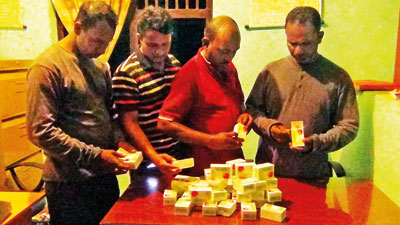News
New drugs slipping through the law
The increasing use of medically-used psychoactive drugs by addicts has placed authorities in a quandary, with few options to control the escalating trend unless new laws are introduced.

5000 tramadol pills were detected in Norochcholai on Friday night. Pic by Hiran Priyankara
The National Dangerous Drug Control Board (NDDCB) said the new drugs used by addicts need to be listed in drug control legislation. As the current law does not apply to the new substances there are legal challenges when prosecuting dealers and users.
Traffickers are changing the chemical formulas in the drugs they sell to addicts, the board’s Assistant Director for Prevention, Education and Training, Pradeep Koholanegedera, said.
The Convention against Illicit Traffic in Narcotic Drugs and Psychotropic Substances Act of 2008 needs to be amended to include the psychoactive (mood and behaviour-changing) drugs supplemented for heroin and cocaine, which are becoming scarce, he said.
A shortfall in heroin is causing drug dealers and mafias to introduce medical drugs that are new and cheaper to sustain their market, Mr. Koholanegedera said.
On Thursday, the Police Narcotic Bureau (PNB) and Customs detected an illegal cache of 15 million tramadol (a narcotic-like pain reliever) pills in a container.
Narcotics are being sold in new preparations such as jujubes and sweets in the crystal form. Sugar-coated strawberry quik (methamphetamine) and dul (duloxetine) in attractive wrappers and sachets are being sold to schoolchildren.
The stimulant, amphetamine, used in treating Attentive Deficit Hyperactive Disorder (ADHD) is being mixed in with cocaine while the drug, ice, contains methamphetamine, used to treat chronic hepatitis and trauma in patients.
In 2008, the United Nations Office on Drugs and Crime (UNODC) included 740 new psychoactive drugs, 12 of which are in circulation in Sri Lanka. They include synthetic cannabis and zombie drugs.
Mr. Koholanegedera said Sri Lanka’s Drug Demand Reduction Programme was inadequate to deal with the increasing number of drug users. There is no comprehensive national policy on drugs.
NDDCB statistics for 2017 show that there are around 250,000 drug addicts in the country, 50,000 of whom are heroin addicts. Around 2,500 addicts undergo rehabilitation every year.
There is serious need for the development of intervention programmes including education, treatment and rehabilitation and crop substitution, the NDDCB said. It is targeting school students in drug education campaigns and said law enforcement agents too need training on emerging drugs.

The illegal cache of 15 million tramadol tablets detected by the Police Narcotic Bureau (PNB) and Customs on Thursday
The Ministry of Health should conduct raids on pharmacies that sell these drugs over the counter, Mr. Koholanegedera said.
The painkiller, tramadol, which has entered the market for addicts, is legally available in about 32 brands, National Medicinal Regulatory Authority (NMRA) Chief Drug Inspector Amit Perera, said. The drug is prescribed for post-operative, neuropathic and cancer patients and legal sales of tramadol are restricted to the Rajiya Osusala.
Law enforcement authorities have not been able to curb the illegal flow of tramadol, Mr. Perera said, adding, “For the last six years around five brands are being smuggled by sea from India”.
He pointed out that pharmacies could not dispense anti-depressants, morphine sulphate (analgesic) and other psychoactive drugs, without a prescription. “Errant pharmacies will be charged in court,” he said.
In 70 cases this year of misuse of tramadol, 12 pharmacies were culprits. The other cases involved possession, smuggling and transportation of the drug.
Last year, 225,000 capsules of tramadol were seized while being transported from Kalpitiya to Negombo. “We conduct raids when we get information and we apprehend suspects with the help of the police, army and the navy,” Mr. Perera said.
Addicts are turning to such drugs because they are cheaper than traditional narcotic substances, Pharmaceutical Association of Sri Lanka President Salutha Athaduwa said. Tramadol tablets sell for Rs. 1 to Rs 1.60 each.
He agreed with Mr. Perera that most pharmacies did not sell these drugs without prescriptions although a few unscrupulous traders crossed the line to make quick money.
“If caught, they will be produced before the Ethical Committee and their licences cancelled,” Mr. Athaduwa said.
The NDDCB is planning to launch a countrywide programme to educate youth on emerging harmful narcotic substances. Police, the Presidential Special Task Force and health and education officials will assist.
The board said there was inadequate funding to tackle the problem at grassroots level. Mr. Koholanegedera said there was a serious need for equipment and expertise. “We need to introduce new technology, increase our workforce and employ professionals. The law enforcement agencies need talented people,” he added.

